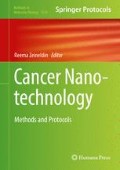Abstract
Artificial antigen-presenting cells (aAPCs) overcome many of the limitations of biologically based adoptive immunotherapy protocols. While these acellular systems can be designed with a variety of parameters, including material type, diameter, and proliferative signals for T cells, we outline methods to formulate and characterize a comprehensive polymeric microparticle aAPC platform. These aAPCs, which can be reproducibly fabricated in large quantities, efficiently stimulate antigen-specific T cell activation and proliferation by both paracrine cytokine signals and engagement of T cell surface proteins.
Access this chapter
Tax calculation will be finalised at checkout
Purchases are for personal use only
References
Steenblock ER, Wrzesinski SH, Flavell RA et al (2009) Antigen presentation on artificial acellular substrates: modular systems for flexible, adaptable immunotherapy. Expert Opin Biol Ther 9(4):451–464
O’Hagan DT, Valiante NM (2003) Recent advances in the discovery and delivery of vaccine adjuvants. Nat Rev Drug Discov 2(9):727–735
Demento SL, Siefert AL, Bandyopadhyay A et al (2011) Pathogen-associated molecular patterns on biomaterials: a paradigm for engineering new vaccines. Trends Biotechnol 29(6):294–306
Perica K, Bieler JG, Schutz C et al (2015) Enrichment and expansion with nanoscale artificial antigen presenting cells for adoptive immunotherapy. ACS Nano 9(7):6861–6871
Sunshine JC, Perica K, Schneck JP et al (2014) Particle shape dependence of CD8+ T cell activation by artificial antigen presenting cells. Biomaterials 35(1):269–277
Fadel TR, Sharp FA, Vudatu N et al (2014) A carbon nanotube–polymer composite for T-cell therapy. Nat Nanotechnol 9(8):639–647
Steenblock ER, Fahmy TM (2008) A comprehensive platform for ex vivo T-cell expansion based on biodegradable polymeric artificial antigen-presenting cells. Mol Ther 16(4):765–772
Labowsky M, Fahmy TM (2012) Diffusive transfer between two intensely interacting cells with limited surface kinetics. Chem Eng Sci 74:114–123
Jain RA (2000) The manufacturing techniques of various drug loaded biodegradable poly(lactide-co-glycolide) (PLGA) devices. Biomaterials 21(23):2475–2490
Schneck JP, Slansky JE, O’Herrin SM et al (2001) Monitoring antigen-specific T cells using MHC-Ig dimers. Curr Protoc Immunol Chapter 17:Unit 17.2
Steenblock ER, Fadel T, Labowsky M et al (2011) An artificial antigen-presenting cell with paracrine delivery of IL-2 impacts the magnitude and direction of the T cell response. J Biol Chem 286(40):34883–34892
Lee SK, Siefert A, Beloor J et al (2012) Cell-specific siRNA delivery by peptides and antibodies. Methods Enzymol 502:91–122
Fahmy TM, Samstein RM, Harness CC et al (2005) Surface modification of biodegradable polyesters with fatty acid conjugates for improved drug targeting. Biomaterials 26(28):5727–5736
Chandler WL, Yeung W, Tait JF (2011) A new microparticle size calibration standard for use in measuring smaller microparticles using a new flow cytometer. J Thromb Haemost 9(6):1216–1224
van der Pol E, Coumans F, Varga Z et al (2013) Innovation in detection of microparticles and exosomes. J Thromb Haemost 11:36–45
Acknowledgments
The authors thank past and present members of the Fahmy Lab, especially Dr. Erin Steenblock-Chia, for pioneering work in scalable adoptive immunotherapy.
Author information
Authors and Affiliations
Corresponding author
Editor information
Editors and Affiliations
Rights and permissions
Copyright information
© 2017 Springer Science+Business Media New York
About this protocol
Cite this protocol
Siefert, A.L., Fahmy, T.M., Kim, D. (2017). Artificial Antigen-Presenting Cells for Immunotherapies. In: Zeineldin, R. (eds) Cancer Nanotechnology. Methods in Molecular Biology, vol 1530. Humana Press, New York, NY. https://doi.org/10.1007/978-1-4939-6646-2_21
Download citation
DOI: https://doi.org/10.1007/978-1-4939-6646-2_21
Published:
Publisher Name: Humana Press, New York, NY
Print ISBN: 978-1-4939-6644-8
Online ISBN: 978-1-4939-6646-2
eBook Packages: Springer Protocols

